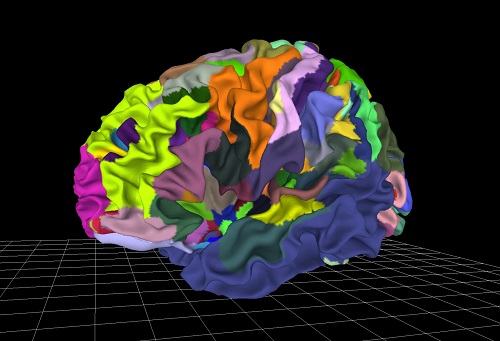

The Jülich Human Brain Atlas forms the core of an open-access multi-level Human Brain Atlas of digital research infrastructure built by the European Human Brain Project. Image credit: Science
The multi-level Jülich Human Brain Atlas developed by the European Human Brain Project team could aid in the study of mental illness and disorders of aging by linking brain networks to their underlying anatomy. The atlas enables a better understanding of brain connectivity and function by mapping microarchitecture at an unprecedented level of detail. The researchers recently outlined the Jülich Human Brain Atlas in the journal Biological Psychiatry, focusing on the cellular and receptor structures of the human brain and how the atlas can be applied to the field of psychiatric research.
Cytoarchitecture, the study of the distribution, density and morphology of cells in the nervous system, has a long history in brain mapping. Neuroscientists noticed structural differences between areas of the cerebral cortex early on and began to divide it into distinct regions. These regions are thought to have important links to brain function and dysfunction.
In addition to the cellular structure, the Jülich Human Brain Atlas also includes maps of the distribution of neurotransmitter receptors that regulate brain activity. Neurotransmitter receptors differ not only between regions, but also between different layers of a region, which is closely related to their connectivity patterns and their role in larger networks. Based on data collected from postmortem brains, the atlas accounts for naturally occurring variability between subjects by generating probability maps in 3D space, rather than just individual brain atlases.
The Jülich Human Brain Atlas is a "living" atlas that grows with new insights into continuously integrating brain regions. It is linked to other maps, for example, those from studies of brain fiber tracts in living humans. Such macro- and micro-data are integrated in the European Human Brain Project's multi-level Human Brain Atlas, publicly accessible on the EBRAINS digital research infrastructure.
The researchers list recent use cases of these tools in different peer-reviewed studies. For example, users can analyze and share high-resolution imaging data and compare it with functional magnetic resonance imaging datasets.
The atlas can also be linked to gene expression data from the Allen Human Brain Atlas, giving researchers diagnostic tools for major depression, dementia, and more.
Editor-in-Chief Circle
In the past century, modern human medicine has advanced by leaps and bounds. However, when it comes to the brain, we have to humbly admit that its operating mechanism is still a "black box" to a large extent. Not to mention anything else, let's just say that neurological diseases that are highly concerned by the society, such as depression, Alzheimer's disease, autism, etc., have different opinions on the exact etiology and pathogenesis of them, and there is no consensus. Of course, there is considerable room for improvement in the therapies and drugs that treat these diseases. Under such circumstances, scientists in the field of biomedicine have no choice but to continue to bury their heads and explore how the brain works and functions from the most basic level, and try their best to promote it from a "black box" to a "white box". .